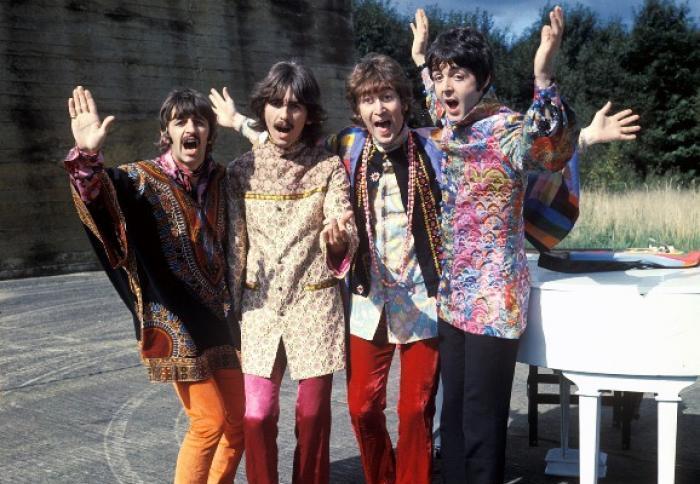Being told that Magical Mystery Tour was a home movie is bit tiring. Self-evidently, The Beatles’ filmic response to the psychedelic experience was not that. They tried, and failed, to hire Shepperton Studios. Known artists like Ivor Cutler and The Bonzo Dog Doo-Dah Band were brought on board. Gavrik Losey, then hot from being an assistant director on Modesty Blaise, worked on it. Masses of extras were employed. Although a self-originated vanity project, none of this points to it being a home movie. The negative reception received at the time seems to have skewed the collective consensus.
Everyone involved in Magical Mystery Tour should be proud of it, and the contributors to this splendid but thin tribute to the film were (even though they still trotted the home movie line out). The co-producers of …Revisited were The Beatles’ Apple organisation, so it was never going to upset the applecart too much or dig too deep. Indeed, much of the contextualisation retrod over-familiar territory, especially Paul McCartney’s centrality to the London underground of 1966/7, which the book Many Years From Now was equally keen to emphasise.
A quarter of the British population watched the black and white broadcast of this quite determinedly colour experience
That was written by Barry Miles who, along with McCartney, cropped up. Also seen were Ringo Starr, George Harrison (via archive footage), Neil Innes, Martin Scorsese, Peter Fonda, Terry Gilliam, Losey and, less pertinently, Paul Gambacini, Paul Merton and Annie Nightingale. Terry Gilliam appeared, but did he have any involvement? John Lennon was heard via recordings of radio and magazine interviews. Testimonies of those who saw the original Boxing Day 1967 broadcast were utterly fascinating. One contributor said his eyes were covered by his dad during the strip club scene. Linda Dickens, then 15, said it “was telling the older generation things were changing”.
A quarter of the British population watched the black and white broadcast of this quite determinedly colour experience. Surely, a great deal of them realised things were and had changed, both for The Beatles and the world? Sergeant Pepper... had been out for six months, “Strawberry Fields Forever” ten. The Beatles’ fascination with the Maharishi Mahesh Yogi had filled newspapers. Was Magical Mystery Tour really that surprising? Wedged into the prime-time schedule the day after Christmas, it apparently was, even though the image of the cheeky mop tops was already history.
Judging by the letters of complaint, a vocal percentage of viewers really hadn’t noticed that The Beatles and the times had changed. McCartney noted that “they had been cheated out of their Christmas special”. Back then, defending Magical Mystery Tour to David Frost, he said “I think a lot of people were looking for a plot and there wasn't one”. “Whether it succeeded was besides the point,” offered Scorsese. Not to viewers in 1967.
The biggest ambiguity was the contradiction between who The Beatles were and who the viewing public thought they were
Ambiguities were central to this Arena documentary and Magical Mystery Tour itself, whether ones that ran counter to perceptions or reality. The role call of ingredients included experimental musicians AMM and filmmakers Bruce Conner and Luis Buñuel. McCartney was a habitué of alternative bookshop Indica and and made Super-8 films he soundtracked with Albert Ayler. Lennon had been at the 14 Hour Technicolour Dream. Yet Magical Mystery Tour corralled a raft of recherché end-of-the-pier/music hall style entertainers of the type familiar from The Beatles’ own childhoods – just like this type of coach trip and the inspirations for “Strawberry Fields Forever” and “Penny Lane”. Ken Kesey and the Merry Pranksters bus trips – a known influence – weren’t mentioned. Nor, by name, was Monty Python or its precursors. Although Scorsese talked incisively and passionately, we didn’t learn if (or when and how) Magical Mystery Tour was broadcast in the States.
The greatest ambiguity was the contradiction between who The Beatles were and who the viewing public thought they were. McCartney said he wanted to tell the world the news, but many of those he intended to reach didn’t want to know.
But with songs like “I am the Walrus”, “The Fool on the Hill” and the creepy-crawling “Blue Jay Way”, Magical Mystery Tour would have been a landmark even if solely filled with rotating kaleidoscopic imagery, or wrestling midgets, or unreal skies, or John Lennon shovelling spaghetti onto a fat lady's plate. And as The Beatles’ Magical Mystery Tour Revisited amply showed, it had much, much more than that.
Watch Paul McCartney discussing the changing society in 1967, from Granada TV's It's so Far Out it's Straight Down














Add comment